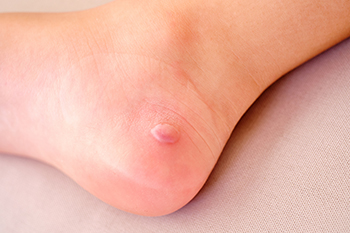
Blisters on the legs and feet are common and often result from friction, wearing poorly fitting shoes, or prolonged activity. These fluid-filled pockets form as the body’s way of protecting deeper layers of skin from further damage. While most blisters are small and heal on their own, they can be painful and interfere with walking or daily activities. It is best not to pop a blister, as this increases the risk of infection. Instead, keep the area clean and cover it with a sterile dressing or blister pad to reduce friction. If a blister does break, gently cleanse it and apply an antibiotic ointment before re-covering with a bandage. Individuals with diabetes or circulation problems should be especially cautious, since even minor blisters can lead to complications. It is suggested that you see a wound care specialist for guidance and treatment when needed.
Why Blisters Can Be Risky for Leg and Foot Health
Blisters are small pockets of fluid that form beneath the skin, often as a result of friction, pressure, or burns. On the feet, ankles, and legs, they are particularly common because these areas endure daily stress from walking, running, and wearing shoes. While many blisters are minor, they can become serious if not treated correctly, especially in individuals with diabetes or poor circulation.
Friction is the most common cause of blisters. Shoes that are too tight, too loose, or not properly cushioned may rub against the heel, toes, or sides of the foot, leading to painful fluid-filled bubbles. Activities such as hiking, sports, or even long periods of standing can also trigger blisters, especially when combined with moisture from sweat.
Other blisters may form from burns, allergic reactions, or underlying medical conditions. On the lower extremities, blisters that break open expose the skin to bacteria, increasing the risk of infection and complicating the healing process. If a blister appears on the ankle, heel, or shin, it may interfere with walking and daily mobility.
Proper care begins with protecting the blister. Keeping the area clean, covered, and free from further friction supports healing. However, large, painful, or recurrent blisters often require professional evaluation. For patients with compromised circulation or nerve damage, even a small blister can turn into a much larger problem if ignored.
A wound care specialist can determine the cause, provide safe drainage if needed, and apply advanced dressings to promote recovery. They can also recommend changes in footwear, activity, or skin protection strategies to prevent future blisters.
If you have developed a blister on your foot, ankle, or leg that is not healing or is becoming more painful, make an appointment with us as soon as possible.
